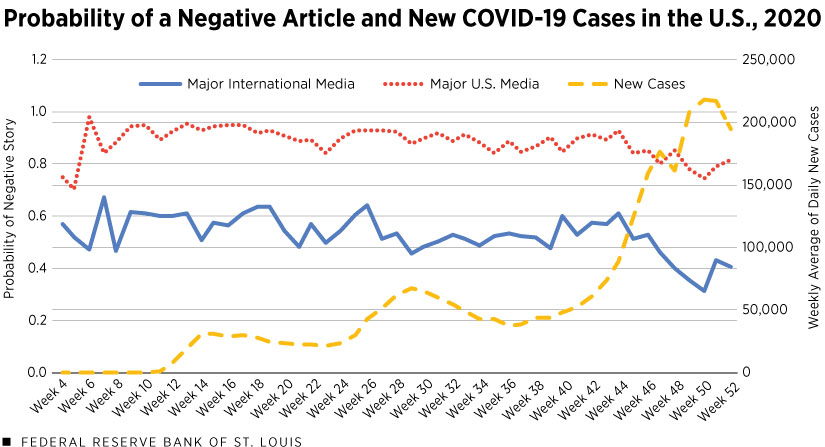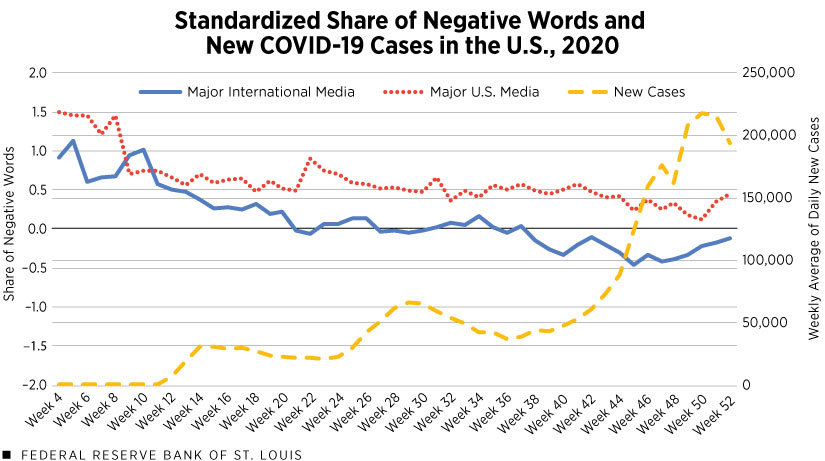Perspectives on U.S. Media Coverage of the COVID-19 Pandemic
KEY TAKEAWAYS
- A working paper by economists Bruce Sacerdote, Ranjan Sehgal and Molly Cook analyzes media coverage of the COVID-19 pandemic.
- Data analysis reveals that major U.S. media coverage was more negative than major international media coverage. And the negative tone increased during the pandemic.
- It is unclear whether U.S. media outlets over-reported negative pandemic news, but they did promote mask wearing and other “prosocial” behaviors more than non-U.S. outlets.
During the COVID-19 crisis, media coverage has been the object of coverage and analysis itself. The discussion of media coverage is often political: Media outlets from one side of the political spectrum are routinely accusing their competitors at the other end of being politically motivated in their reporting.
This article comments on a fascinating working paper by economists Bruce Sacerdote, Ranjan Sehgal and Molly Cook, which offers a systematic analysis of the relationship between pandemic-related media coverage and the actual evolution of the COVID-19 situation.
The authors’ work can be described as “sentiment analysis,” a field of study in which researchers assess, among other things, the effects associated with a text. In the Sacerdote, Sehgal and Cook working paper, the authors classified news stories (e.g., print articles and television transcripts) as positive or negative, and compared the degree of negativity (the share of negative words) across news outlets, across U.S. and non-U.S. outlets and against the actual evolution of the virus.
In the working paper, Sacerdote, Sehgal and Cook analyzed the text of about 43,000 English-language COVID-19-related news stories from Jan. 1 to Dec. 31, 2020. The stories were from four sources, according to the article:
- The top 15 major U.S. media outlets defined by their readerships/viewerships (Newsweek, USA Today, Los Angeles Times, ABC, CBS, CNN, Fox News and others)
- The general U.S. media
- Major international media (The Daily Mirror, India Today, The Sunday Herald, The Sydney Morning Herald, The Times of India, Toronto Star and others)
- The general international media
The authors ranked stories using two metrics. First, using statistical and machine learning techniques, they estimated the probability that a story would be deemed “negative” by a human reader. For example, a story with the phrase “death toll” is more likely to be negative in tone, while an article with the phrase “clinical trial” is less likely to be negative, the authors noted. Second, they used a well-established dictionary of positive and negative words and textual analysis tools to compute the fraction of negative words in each news story.
COVID-19 and the Findings of Sacerdote, Sehgal and Cook
The first figure below reviews findings of Sacerdote, Sehgal and Cook, which show the probability that a story was negative in the major U.S. media and the major international media. The data are then compared to the weekly average of daily new cases in the U.S.
Using data from the working paper, the second figure shows the “standardized” share of negative words. That is, instead of showing the actual share of negative words in, say, major U.S. media stories, the U.S. major media line shows the difference, with the mean number of negative words across COVID-19-related stories in all media. Thus, a positive number indicates that a story is more negative than the average story about COVID-19. A negative number indicates that a story is less negative.

SOURCE: Sacerdote et al., 2021.
NOTE: This figure is based on updated information from the authors.

SOURCE: Sacerdote et al., 2021.
NOTE: This figure was produced using data from the Sacerdote, Sehgal and Cook working paper.
Data analysis in these figures reveals that the evolution of media negativity appears unrelated to the evolution of the virus. In other words, the ups and downs of the numbers of new cases are not matched by any changes in media negativity. In the first figure, the probability that a major U.S. media story is negative is noticeably stable over time, regardless of the evolution of new cases; in the second figure, the downward trend in the standardized share of negative words is similarly unresponsive to new cases.
These figures are consistent with and confirm data gathered by Sacerdote, Sehgal and Cook through formal statistical tests. The authors found that, indeed, average media negativity over time was not correlated with new case counts.
Both figures show that major U.S. media were more negative in tone than major international media, affirming the assertions of Sacerdote, Sehgal and Cook. On average, 90% of stories published in major U.S. media outlets were negative in tone, while 54% of non-U.S. stories were negative. Similarly, the authors found the share of negative words in U.S. major media stories was higher than in non-U.S. stories.
Sacerdote, Sehgal and Cook found the negativity (measured by the share of negative words) in major U.S. media to be noticeably higher (22%) than in major international media, while the general U.S. media were significantly less negative (31%). In their working paper, the authors wrote that the positive or negative tone of a story depended also on its topic of emphasis. They differentiated between three types of stories: vaccine-related stories, stories about the increases and decreases in case counts, and stories about reopening (e.g., businesses, schools, parks, etc.), according to the article. Major U.S. media were 38% more negative than international major media when presenting vaccine-related stories, 19.5% more negative when covering COVID-19 case counts and 17% more negative with reopening stories.
Sacerdote, Sehgal and Cook noted that major U.S. media were generally more negative in tone than other media, including for stories unrelated to COVID-19. But they found that the negative tone of the U.S. major media has increased during the COVID-19 crisis. Interestingly, the authors noted that stories published in scientific media outlets were less negative in tone than in the average publication.
Media Coverage before COVID-19
Another point that Sacerdote, Sehgal and Cook brought up is how the negativity of COVID-19 coverage in major U.S. media may have important mental health consequences for the U.S. population: “In discussing this increase in mental health problems, U.S. Centers for Disease Control and Prevention recommend against heavy consumption of news stories about the pandemic,” the authors wrote. Indeed, on its website, the CDC advises Americans to “take breaks from watching, reading, or listening to news stories.”
Negativity in news outlets is not recent. As early as 1979, a well-known article by Barbara Combs and Paul Slovic already made the point that newspapers tend to “overemphasize ... homicides, accidents and disasters and underemphasize diseases as causes of death.” What Combs and Slovic meant by “overemphasize” is, for example, that the media’s representation of accidents as a cause of death is unrelated to the actual risk of dying from an accident. The recent findings by Sacerdote, Sehgal and Cook are very similar in nature: The negative tone of the coverage of the COVID-19 crisis is uncorrelated with the actual evolution of the disease.
More recently, in a 2008 article, Larisa Bomlitz and Mayer Brezis found that for a variety of health risks, the number of media reports was inversely correlated with the actual number of deaths. Specifically, they counted the number of media reports (U.S. newspapers plus television and radio transcripts) on a few health issues, such as severe acute respiratory syndrome (SARS), the West Nile virus, bioterrorism, AIDS, smoking and, finally, physical inactivity.
Bomlitz and Brezis then computed the death rate in the U.S. in 2003 associated with these health issues and found a significantly negative correlation between death rates and media reports: “In the United States, SARS and bioterrorism killed fewer than a dozen people in 2003, but together generated over 100,000 media reports,” they wrote. “Almost 800,000 people each year die from the consequences of smoking and physical inactivity, but these triggered far less media attention.” Bomlitz and Brezis concluded that, “Emerging health hazards are over-reported in mass media compared to common threats to public health.”
Conclusion
The Sacerdote, Sehgal and Cook working paper raises again the question of whether the media misled their audiences by “over-reporting” negative news. In considering the question, one would first need to define “over-reporting.” If there were a “best” or “optimal” level of media coverage, it could depend on more than just the prevalence of the virus and, thus, there would be no reason coverage should reflect exactly this prevalence.
Since many media sources in the U.S. are for-profit businesses, one definition of “best” could be “profit-maximizing.” That, of course, would be best for the media. But what about society as a whole? This is not an easy question. In fact, it is part of a broader, age-old question: Is there a disconnect between what is good for individuals (people or businesses) and what is good for society as a whole?
In the case of COVID-19, media outlets may have done their reporting with profit-maximizing motives. Yet, they also promoted what Sacerdote, Sehgal and Cook call “prosocial behaviors.” According to the authors, despite being more negative overall, U.S. major media sources were more likely to mention the benefits of mask wearing and socially distancing than their non-U.S. counterparts.
References
Bomlitz, Larisa J.; and Brezis, Mayer. “Misrepresentation of Health Risks by Mass Media.” Journal of Public Health, 2008, Vol. 30, No. 2, pp. 202-204.
Combs, Barbara; and Slovic, Paul. “Newspaper Coverage of Causes of Death.” Journalism Quarterly, 1979, Vol. 56, No. 4, pp. 837-849.
Sacerdote, Bruce; Sehgal, Ranjan; and Cook, Molly. “Why Is All COVID-19 News Bad News?” Working paper, March 2021.
Views expressed in Regional Economist are not necessarily those of the St. Louis Fed or Federal Reserve System.
For the latest insights from our economists and other St. Louis Fed experts, visit On the Economy and subscribe.
Email Us


